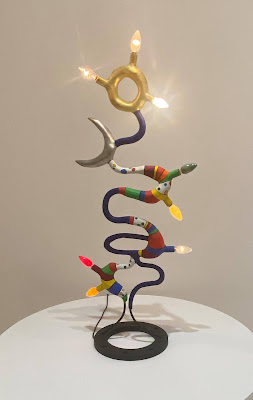July 22, 2021
We started our second day in NYC by picking up soft egg and avocado sandwiches for breakfast at Factory Tamal and taking them to nearby Seward Park, where we sat on a bench and watched the antics of energetic children, noted the numbers of what appeared to be families enjoying the park (or nannies with children?), and wolfed down the sandwiches.


One of the things NYC does exceptionally well is provide open space that can be enjoyed by all. Over 30,000 acres of land, an impressive 4% of the city, are dedicated parks. According to www.nycgovparks.org, there are more than 5,000 individual properties in the park system, which include about 1,000 playgrounds, 1,800 basketball courts, 550 tennis courts, 65 public pools, 51 recreational facilities, 15 nature centers, 14 golf courses, and 14 miles of beaches. When my acquaintances tell me they could never live in NYC because they would miss nature, I know they haven't experienced the neighborhood parks.
This is NYC.
Of course, NYC also has its problems, but they seem to address them in their own unique way.


Don't you love this mobile flower bed?
It was a day made for walking, so after we finished our breakfast, we headed over to the East River, which is criss-crossed by three bridges.
 |
| Brooklyn, Manhattan, and Williamsburg Bridges. |
Underneath the freeway, next to the water, a dance lesson was in progress. This is New York City.


Under an architectural awning, four large swings were full of relaxing locals. More people lounged on the steps. It could have been an upscale neighborhood, but it was a low-income neighborhood in NYC.
Just a block away are tall brown brick buildings that my son said are government housing. I'm not pretending that NYC is without major flaws, but on the morning we were there, this location was clean, well-tended, and full of happy people.
Further down the pavement, there are pieces of exercise equipment for anyone who wants to use them.
 Manhattan and Williamsburg Bridges, behind us, made a magical backdrop. This is NYC.
Manhattan and Williamsburg Bridges, behind us, made a magical backdrop. This is NYC.


NYC has 8.2 million people. That morning, from our view through the Manhattan Bridge, it was a model metropolis. We could see the spike on top of One World Trade Center in the distance. It was all a bit surreal.
Time to head to our next destination,
Just a block from the water where we had been, this is also NYC.
The subways are
definitely NYC.
And art, art of all kinds, is NYC.
MoMa PS1 was our next destination. NYC is the art capital of the U.S., the reason our son lives there. This art museum had an exhibition featuring works by Niki de Saint Phalle, a French-born, American-raised artist perhaps best known for her collaboration with sculptor Jean Tinguely on the
Stravinsky Fountain next to the Pompidou Museum in Paris.
The first piece of her work is in the courtyard of the museum: La Femme et L'oiseau Fontaine, or The Woman and the Fountain Bird. The faceless, swimsuit-clad body is spraying water from her breasts.
On the concrete walls surrounding the courtyard are stained glass window-like sculptures by Mexican artist Raúl de Nieves, who as a developing artist was impacted by Saint Phalle's exuberant use of color.
The former school rooms, now exhibition spaces, contained many more pieces by Saint Phalle.
This is a model for a children's play structure that was erected at a private resident in Belgium. The end product was 21 feet tall and 110 feet long. The monster's tongue is a slide. Inside there is a playroom, bathroom, kitchen, and bedroom.
 |
| Le dragon de Knokke - The Dragon of Knokke (1973-1975) |
These are models for several of the sixteen sculptures that are part of the previously referenced Stravinsky Fountain in Paris. In the actual fountain, these are much, much larger. Many of them spit water as they move.
In 1996, Saint Phalle was commissioned to make a play structure for the backyard of a San Diego home. The result was
Gila, a dragon based on the venomous lizard found in the southwestern US.
Here is another model, but I don't know if this one was ever made in full size.
 |
| The Sphinx (1984) |
Front view:
This is probably my favorite piece. I love the idea of the Tree of Life made from the serpent in the Garden of Eden (at least that's how I interpret it). On one side are the good things that are part of life (music, wine, stars, friendship, art, humor, life, etc.) and on the other side are the bad things (illness, intolerance, racism, injustice, death, etc.).
 |
| L'arbre de vie - The Tree of Life (1990) |
Giant magnet-like figures covered one wall.
I didn't get the name of this one, but it is quintessential Niki de Saint Phalle, don't you think?.
Saint Phalle also created a number of altars. This one is embellished with bats, rats, crucifixes, and guns. The acronym "O.A.S." engraved on the base stands for "Oeuvre d'Art Sacrée" (Sacred Artwork), and also references the Organisation Armée Secrète, a French rightwing terrorist group.
 |
| Autel O.A.S. (1962-1992) |
Left: Le fil du discours - The Line of Conversation (1980) and The New Man Is Coming (1980-1981):
This is another model for a structure that I don't think was actually built, but isn't it fun? These structures are every kid's dream.
 |
| Le palais (Auberge) - The Auberge Palace (1978-1979) |
More models:
Another favorite:
 |
| TV on the Brain (1977) |
Apparently Saint Phalle was not a fan of #43.
 |
| George W. Bush (2001) |









































Fun walk to the East River and fun time at the MOMA. Lunch next to the breasty statue at the MOMA was wonderful (you covered that in a prior food post).
ReplyDelete